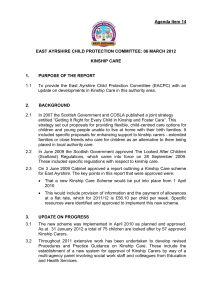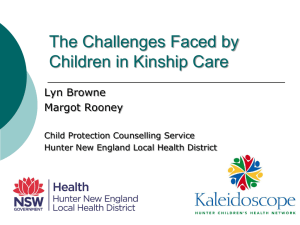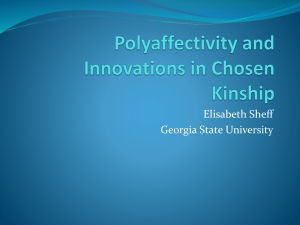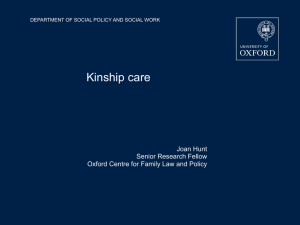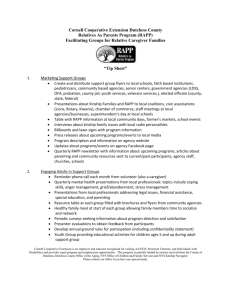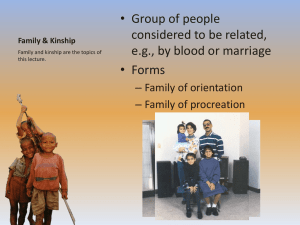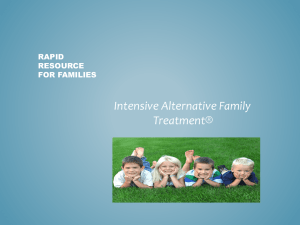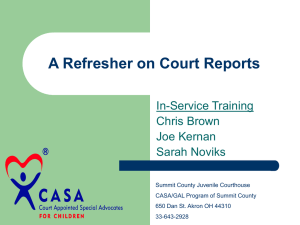211-iFoster Kinship Navigation Portal
advertisement
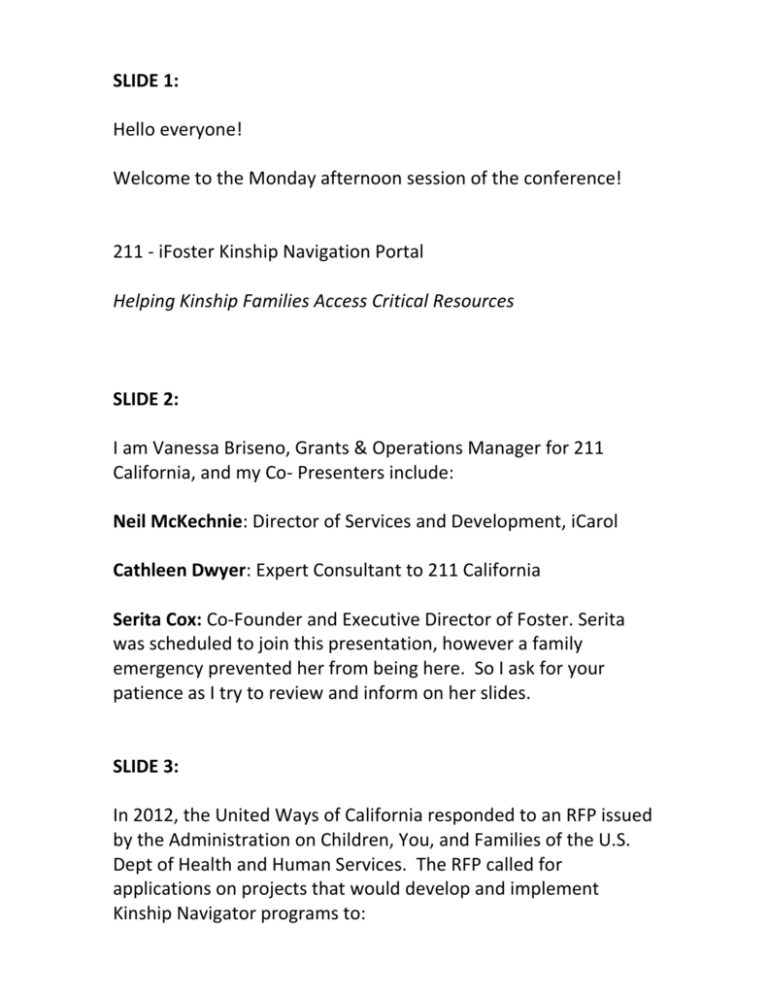
SLIDE 1: Hello everyone! Welcome to the Monday afternoon session of the conference! 211 - iFoster Kinship Navigation Portal Helping Kinship Families Access Critical Resources SLIDE 2: I am Vanessa Briseno, Grants & Operations Manager for 211 California, and my Co- Presenters include: Neil McKechnie: Director of Services and Development, iCarol Cathleen Dwyer: Expert Consultant to 211 California Serita Cox: Co-Founder and Executive Director of Foster. Serita was scheduled to join this presentation, however a family emergency prevented her from being here. So I ask for your patience as I try to review and inform on her slides. SLIDE 3: In 2012, the United Ways of California responded to an RFP issued by the Administration on Children, You, and Families of the U.S. Dept of Health and Human Services. The RFP called for applications on projects that would develop and implement Kinship Navigator programs to: 1. Assist kinship caregivers, through information and referral systems and other means, to learn about, find, and use existing programs and services to meet their own needs and the needs of the children they are raising; and 2. Promote effective partnerships between public and private, community and faith-based agencies to better serve the needs of kinship caregiver families. Implementation on these Projects called for strong collaboration between the grantee partners; the public Child Welfare agency, and the agency administering the Temporary Assistance for Needy Families (TANF) program. These Kinship Navigator programs are designed to promote protective factors as a means to support social and emotional well-being and healthy, positive functioning in kinship caregiver families served or potentially served by the Child Welfare and TANF systems. As demonstration projects, these grantee programs will serve as models for other States and communities seeking to implement family connection services for their Kinship population – a place where they can look to for guidance, insight, and possible replication for effective ways that Child Welfare and TANF agencies can collaborate to meet the needs of Kinship children, youth and families. SLIDE 4: RFP Overview: The U.S. Department of Children, Youth and families called for applications on projects that would develop and implement Kinship Navigator programs to: 1. Assist kinship caregivers, through information and referral systems and other means, to learn about, find, and use existing programs and services to meet their own needs and the needs of the children they are raising; and 2. Promote effective partnerships between public and private, community and faith-based agencies to better serve the needs of kinship caregiver families. SLIDE 5: Grant Term: 3 year grant • First two years to be focused on the planning and implementation of the Project • Third year focused on Evaluation SLIDE 6: Grant Partners iFoster: an online resource focused on closing the economic gap between what it costs to raise a child and what child welfare and social services provides. United Ways of California: the statewide network of local united ways focused on improving the health, education and financial results for low-income children and families by enhancing and coordinating advocacy and community impact. 2-1-1 California: the statewide network of local 2-1-1 information and referral providers. This partnership is very unique in that it offers the opportunity to provide Kinship children, you and families the opportunities to be connected to private enterprise resources via iFoster (and those include (discounts to major theme parks, discounts to major department stores, and memberships to major retailers such as Costco and Sam’s Club) SLIDE 7: Edgewood: a multi-pronged agency that supports youth and their families through life’s challenges with a full continuum of behavioral health services. Our work focuses on issues such as mental health, family relationships and life skills, and our programs range from prevention and early intervention to community-based, day and residential treatment services. The Edgewood Institute for the Study of Community-Based Services (The Edgewood Institute) focuses on research and evaluation of Edgewood services and those of similar programs nationwide with the goal of continuously improving services to children and families. We are thrilled to have Edgewood as the Evaluator for our Project because they not only conduct the critical research needed to ensure that the needs of Kinship families are met, but they also work with a population of children and youth that are experiencing challenges and family unconnectedness. SLIDE 8: Our Work: 211 – iFoster Kinship Navigation Portal SLIDE 9: The three Grantee partners submitted an application to the Dept of Health and Human Services for a Demonstration Project that would: Develop a one-stop, comprehensive resource portal – 211-iFoster Kinship Navigation Portal – containing all requested and available services and resources for foster youth and caregivers in 4 counties across California in order to: SLIDE 10: Purpose • Provide supportive services to Kinship caregivers • Meet the needs to Kinship families • Promote family well-being and health • Promote partnership among public and private agencies SLIDE 11: Project Goal To enroll 13,000 Kinship caregivers into the Portal A secondary goal is to get 5,000 of those caregivers to agree to participate in the evaluation process (which we’ll review later). SLIDE 12: We have designed the Portal so that it is an innovative model that: • Focuses on the needs of formal and informal kinship families • Is designed to create an integrated referral and coordinated service delivery solution for kinship caregivers • Addresses the most critical areas of Kinship families (such as cost of living, legal services, digital divide and communications, academic supports, health and well-being, and career supports for youth) • Provides access to private enterprise resources (this is where the iFoster connection comes in: They provide the discounts to major attractions and retailers across the country as well as membership to large markets and access to free computers and digital literacy services). SLIDE 13: 2-1-1 Participation Riverside Monterey San Bernardino Ventura We originally selected seven counties in California to participate in this Project along with 3 comparison counties that would help us (and especially our Evaluators) determine the full impact of our work in the participating counties. We experienced some significant issues early in the planning and implementation stages of the Project, which caused delays in our Project timeline and which subsequently caused up to tighten up our reach to four counties. These counties were chosen based on: 1. Estimated population of Kinship youth and families in the 2. 3. 4. 5. county The County’s Child Welfare Agency’s willingness and readiness to participate The number of nonprofit family support agencies available in those County to assist with the support navigation for those Kinship Families Our 2-1-1 County readiness to engage and support the implementation of the Project AND…. Each county’s ability to support the project and get the word out to their residents. SLIDE 14: County 2-1-1 Benefits This Project has allowed the 4 counties that are participating in this effort to experience many benefits. For one: it advances our California 2-1-1 network’s vision for database alignment by supporting and promoting quality and consistency within their individual resource databases. It also gives us the opportunity to showcase a system that maintains consistent style, quality, and use of taxonomy terms. And it allows us to showcase our data in real-time! SLIDE 15: Why is this type of Project Important? AND How will this Self-Service Resource Portal make a significant difference in the lives of Kinship Families? SLIDE 16: National census data tells us that 1 in 11 children will spend time in foster or kinship care before they reach their 18th birthday • 400,000 live in foster care. • 2.7 Million live in kinship care that we KNOW of, but we’re confident that there are many more Kinship Families out there who may not know that they’re Kinship families. These are families who take in relative children following the death of a biological parent or parents, their incarceration, court removal and/or other circumstances. • Average age that a child is removed from their biological families is estimated at < 6 years old SLIDE 17: We also know that without sufficient resources and supports to help Kinship and Foster youth, their futures are grim • 46% won’t get their GED by 19 • 70% will be on welfare • 51% will be homeless • 50% will be unemployed • 25% will be incarcerated • Less than 3% will earn their BA SLIDE 18: According to national statistics provided by the Children’s Bureau, kinship care provides more stability to the life of a child removed from his or her family, however it also provides them with worse outcomes. • Early placement with kin leads to higher stability and permanency • Reunification & exits to permanency are higher than with foster care • HOWEVER: Well-being is worse with kinship youth. At age 24, they are showing higher rates of ADHD, PTSD, substance abuse, anxiety, depression and suicidality. SLIDE 19: • In 2011, it cost over $1,000 a month to raise a child. This is what the average family in the US paid in 2011 • Foster Families on average receive less than 50% of this amount • Kinship Families on average receive less than 25% of this amount to help raise their kids • And many Kinship Families don’t receive anything at all SLIDE 20: • In fact, most Kinship Families do not receive any of the benefits they are eligible for • For example … (read a couple of examples from slide) • They don’t get these benefits for a variety of reasons, but a big reason is that Kinship Families don’t know these benefits exist SLIDE 21: This Project is a Demonstration of how Technology can help support Kinship families. • We conducted a series of focus groups with asking “Would an online, self-service resource portal” help close the economic and service access gap? • 100% of kinship focus groups said they would use it – including those who did not have direct access to technology • Use it for information to aid them in getting assistance and the resources they need • Believe it would be useful to all child welfare members including: caregivers, case workers/social workers, schools and colleges SLIDE 22: Our early focus Groups in Monterey and Riverside counties identified and prioritized 10 Resource Categories that are Significant to Kinship children, youth and families. We have found that these are consistent with the national needs of Kinship families. 30 25 20 15 10 5 0 We have found that these are consistent with the national needs of Kinship families. SLIDE 23: We also know that Kinship Caregivers want more than Government and Public Resources. They have expressed the need for: 30 25 20 15 10 5 0 SLIDE 24: And we know that additional supports are also critical for them: 25 20 15 10 5 0 Expert advice Ratings of Help to get Live help A local including programs and resources you (phone, chat, individual or videos, forums, services by have found on email) when org you can trainings and others in the the portal navigating the visit who can ask the expert child welfare when provider portal to sit down with for specific community says no explain you and get resource programs you gov't categories benefits you found on the portal SLIDE 25: • Our solution is to provide a one-stop shop of all the resources a Kinship or Foster Family needs SLIDE 26: This NAVIGATION PORTAL: (1) addresses the current lack of awareness and information by Kinship caregivers about existing social service resources in their community; (2) reduces the complexity of navigating different social service and community systems and providers; AND, via the COUNTY COLLABORATIVES (3) provides kinship caregiver referral and usage data to county collaboratives to inform service delivery and coordination activities; and It Also (4) augments limited social service resources with private sector resources via the iFoster partnership. The COUNTY COLLABORATIVES, in particular, will support the use of the resource portal among their kinship caregivers, agencies and service providers. Additionally, County Collaboratives will be provided with reports on referrals, usage, approvals, rejections and failure to follow‐up (either by caregiver or service provider). This reporting will be integrated into ongoing collaborative meetings and CalWORKs‐Child Welfare partnerships to review the effectiveness of service delivery, identify gaps, address issues and improve services and service coordination. SLIDE 27: • We’re fortunate to have iFoster as a grant partner. It’s an online, self-service resource portal with 100s of national, regional and local resources that offer supports and benefits to Kinship and Foster Families • Resources are either free or greatly discounted • Resources come from Companies, Government, Non-Profits or Faith-Based Organizations • All resources and all partners are vetted and negotiated by iFoster to ensure the resource is real, available and helpful to our Families • All resources are also requested and rated by the Community so that only the products and services the Community wants and values are in the portal SLIDE 28: • As I mentioned, there are 100s of resources • Some are National like a special membership with Costco, free eye exams and eye glasses with Sight for Students, discounts at Disney and with Mattel toys • And we have Local Resources too including Resource Hubs like Family Resource Centers, Grandparents Raising Grandchildren. These are centers that can provide access to many local resources and can help Families sign up for government benefits. • And 100s of free resources from our 2-1-1 partners that cover all kinds of needs from Food, Clothing, Housing Expenses and After School Activities, and family well-being supports SLIDE 29: • All these resources are available through our collaborative online portal HAND OVER TO NEIL for Slide 30 HAND OVER TO CAT SLIDE 46: (If we still have time) Member Registration To use the Kinship Navigation Portal, you must be a registered member. • Membership is FREE • But you must be one of the following (read the 6 categories) Transition-age foster, kinship and probation youth (age 16-24) Foster families Kinship families or relative/near-relative caregivers Legal guardians Adoptive families Any agency or organization serving any of the above You will be asked to provide the Name of an Agency or Organization and a Contact Person at that Agency who can Confirm your Member Type Appropriate Agencies include: DPSS / Child Welfare Foster Family Agency Grandparents Raising Grandchildren CFLC Kincare Schools Churches Foster or Kinship Support Groups Guardianship Attorneys SLIDE 47: This is what the Membership Registration Form looks like. As you can see, we ask for only a limited amount of information The information is to verify your Member Type and to ensure that you only see the resources that you are eligible for SLIDE 48: You will be asked to set your Preferences The Navigation portal will automatically filter resources based on your Preferences so you will only see what you are looking for and are eligible for You can change your Preferences any time you are logged into the portal SLIDE 49: Registration Complete. Our application needs to be reviewed and approved by the iFoster team before you can get started. SLIDE 50: Depending on your location, the Portal will ask if you’re a Kinship Caregiver in one of the participating 2-1-1 counties. If so, we really want the opportunity to evaluate your experience of the Navigation Portal, so we offer an incentive to Kinship families for their participation in the evaluation surveys and process. HAND OVER TO CAT.
